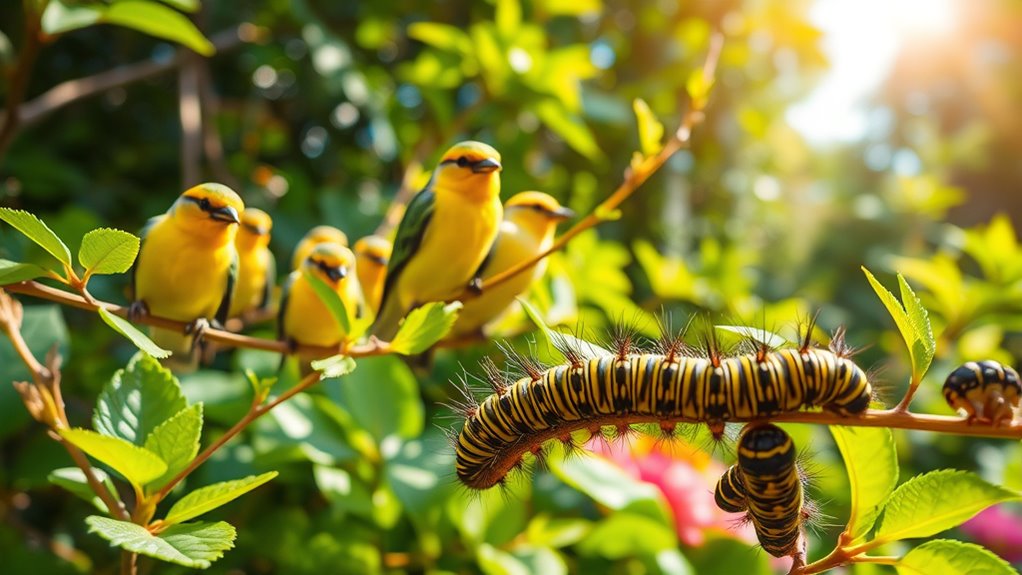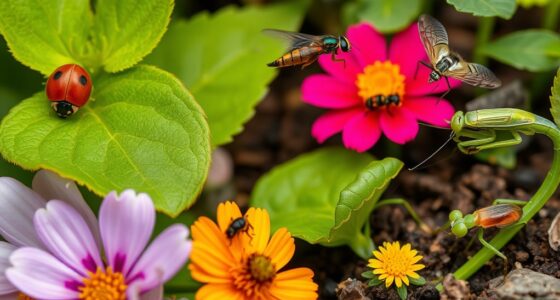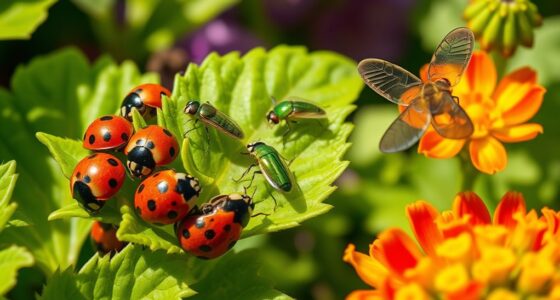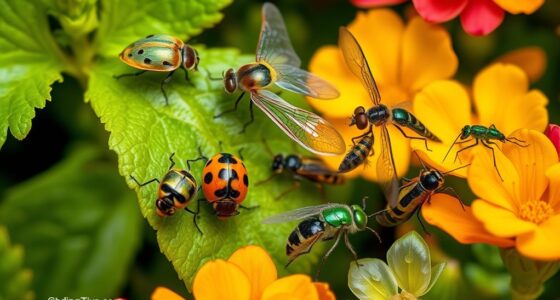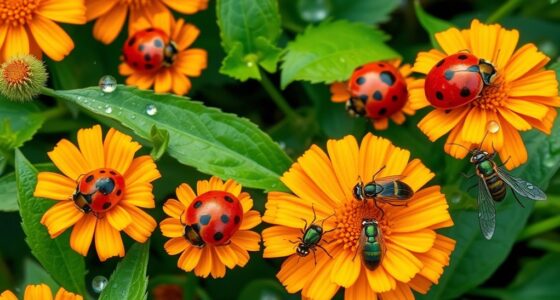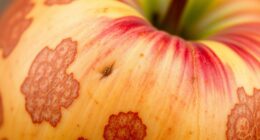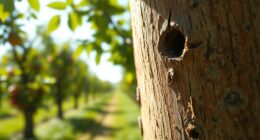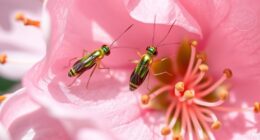To encourage birds for caterpillar control, start by planting native trees, shrubs, and flowering plants that provide plenty of food and shelter. Install birdhouses and keep water sources accessible and clean. Avoid using pesticides, as they can harm beneficial insects and birds. Create a diverse and safe habitat with layers of plants and natural nesting spots. Keeping these elements in place helps attract insectivorous birds that naturally manage caterpillars—learn more about creating an ideal environment below.
Key Takeaways
- Plant native shrubs and trees that attract insectivorous birds to naturally control caterpillar populations.
- Provide water sources and nesting sites to encourage bird residency and increase predation on caterpillars.
- Maintain habitat diversity with layered plantings to support diverse bird species that feed on caterpillars.
- Avoid pesticides; promote organic pest control methods to protect bird populations and their food sources.
- Install and regularly clean birdhouses and shelters to attract and sustain bird species that help manage caterpillars.
Providing Food Sources to Attract Birds

To attract birds that can help control caterpillars, you need to provide reliable food sources. Bird migration plays a key role here, as many species visit your area seasonally, seeking nourishment. By planting native trees and shrubs that produce berries and seeds, you support seed dispersal, encouraging birds to stay and forage. Offering a variety of food, such as seed feeders or fruit-bearing plants, attracts different species, increasing your chances of bringing in insectivorous birds. These birds rely on these food sources during migration stops or as year-round residents, naturally helping reduce caterpillar populations. Consistently providing this sustenance encourages birds to frequent your garden, boosting their natural pest control abilities through their feeding habits.
Creating Safe and Shelter-Rich Habitats
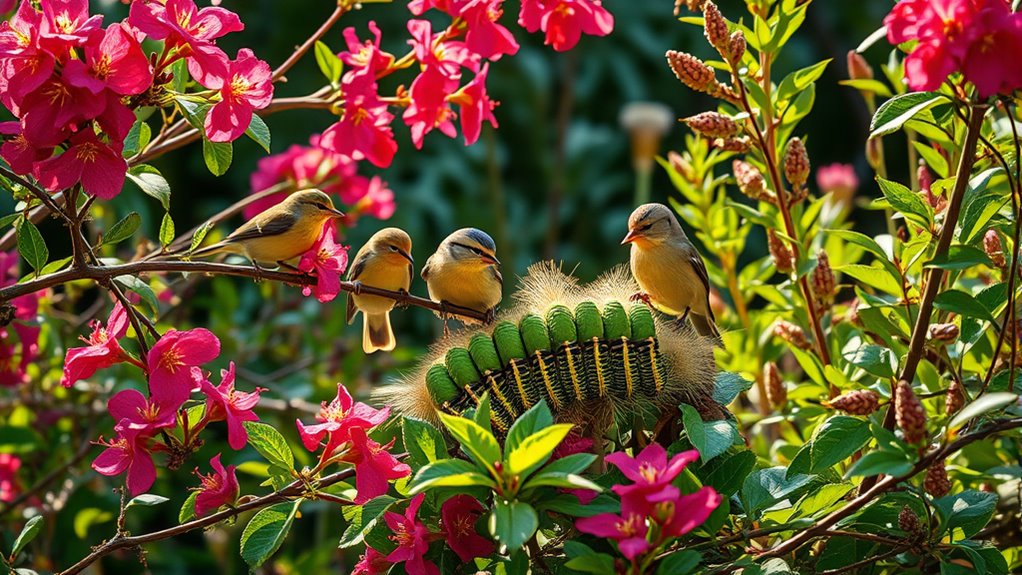
You can encourage birds by providing natural nesting sites and dense vegetation that offer shelter and safety. Make sure birds can access these areas easily without disturbance. Creating such habitats helps protect both the birds and the caterpillars they control. Additionally, understanding the timing of natural events like sunrise times can help you plan the best moments for observing and supporting local bird populations.
Providing Natural Nesting Sites
Providing natural nesting sites is essential for encouraging birds that prey on caterpillars to settle and raise their young in your garden. When you offer suitable nesting habitats, you support bird migration patterns and help them find safe spots to reproduce. By creating sheltered areas with natural materials, you reduce the risk of nest predation, making it more likely that birds will stay and raise healthy offspring. Avoid trimming trees or shrubs excessively, as dense branches provide protection from predators and harsh weather. Offering nesting cavities or leaving dead branches can also attract cavity-nesting species. When birds feel secure and have access to safe nesting sites, they’ll establish territories, increase their numbers, and naturally control caterpillar populations, benefiting your garden’s health. Incorporating nesting boxes and shelters can further enhance habitat availability and support diverse bird species in your area.
Incorporating Dense Vegetation
Incorporating dense vegetation into your garden creates essential shelter and safe havens for birds that prey on caterpillars. These thick plantings support bird migration by providing reliable cover during seasonal movements. Dense shrubs and tall grasses offer ideal nesting sites, ensuring birds can lay eggs and raise chicks during the appropriate nesting timing. By creating a variety of layered habitats, you help attract different species, increasing predation on caterpillars. This shelter-rich environment also protects birds from predators and harsh weather, encouraging them to stay longer. As a result, your garden becomes a natural pest control hub. Focus on native plants to guarantee the habitat remains suitable throughout the year, supporting bird populations and boosting their role in managing caterpillars effectively. Incorporating security zone info can help safeguard these valuable habitats from invasive species or disturbances, ensuring their longevity and effectiveness.
Ensuring Safe Bird Access
To guarantee birds can access your garden safely and thrive, it’s essential to design habitats that offer clear, unobstructed pathways and secure shelter. Make certain your bird flight paths are free from obstacles like dense branches or wires that could hinder movement. Creating open spaces alongside shrubbery provides safe routes for birds to navigate, especially during busy times like migration. Incorporate shelter options such as well-placed trees, nest boxes, and dense bushes to protect birds from predators and harsh weather. By aligning your habitat design with natural bird migration patterns, you support their seasonal movements and everyday activities. Emphasizing the use of natural materials in your habitat can also help attract a variety of bird species. Thoughtfully arranging these elements encourages safe access, reduces stress, and promotes a healthy environment for birds that help manage caterpillars naturally.
Installing Bird Nests and Housing
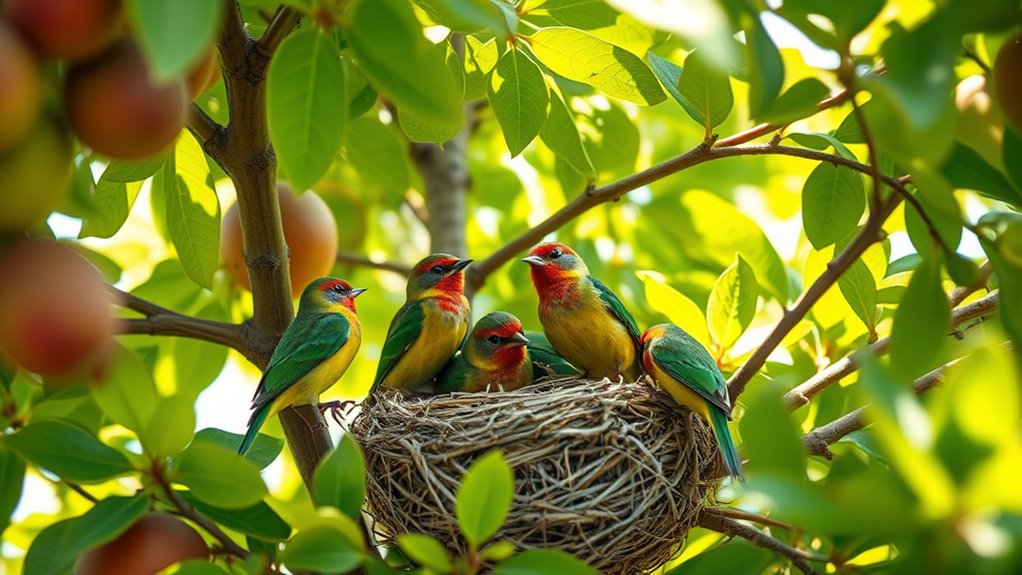
To encourage birds to help control caterpillars, you need to choose the right spots for their nests and housing. Picking suitable sites and the proper types of birdhouses makes it easier for birds to settle in and stay safe. Regularly maintaining these habitats guarantees they remain inviting and effective for pest management. Incorporating native bird species into your habitat can further improve pest control effectiveness.
Selecting Suitable Nest Sites
Choosing the right location for bird nests is essential for attracting and supporting insect-eating birds that can help control caterpillars. To do this effectively, consider how migratory patterns influence bird presence and nest site competition. Select sites that are safe from predators and well-hidden from human activity. Guarantee they are near abundant food sources and have suitable vegetation. Additionally, understanding affiliate disclosures can help you find quality nesting materials through trusted sources. Here are four key points:
- Place nests in areas with minimal nest site competition from other species.
- Choose locations that align with migratory birds’ timing and patterns.
- Avoid sites prone to flooding or extreme weather.
- Opt for sheltered spots that provide safety and stability for breeding.
Choosing Appropriate Housing Types
After selecting suitable nest sites, the next step is installing the right types of bird housing to attract and support insect-eating birds. Choose birdhouse designs that match the species you’re targeting, ensuring proper size, entrance hole dimensions, and ventilation. For example, smaller holes attract wrens and chickadees, while larger openings suit bluebirds. Consider housing material choices carefully; wood is popular because it insulates well, but avoid treated or painted wood that could harm birds. Use untreated, natural materials like cedar or pine, which resist weathering. Mount the birdhouses securely at appropriate heights and locations, away from predators and harsh weather. Properly selected birdhouse designs and housing materials will encourage birds to settle, helping you manage caterpillars naturally and effectively. Additionally, providing proper placement can significantly increase the likelihood of attracting the desired bird species.
Maintaining Bird Habitats
Maintaining bird habitats by installing nests and housing requires regular attention to guarantee they remain inviting and safe for birds. Properly maintained nests support avian migration and ensure birds have secure spots for breeding. To enhance habitat quality, consider these steps:
- Regularly clean and inspect nests to prevent disease and damage.
- Use native materials to encourage natural bird behaviors and support bird song conservation.
- Position nests at appropriate heights and locations to facilitate avian migration and minimize predator risks.
- Ensure housing is weather-resistant and free from pests to keep birds healthy and active.
- Incorporate risk management strategies by monitoring for potential hazards that could threaten the nests or the birds.
Maintaining Water Sources for Birds
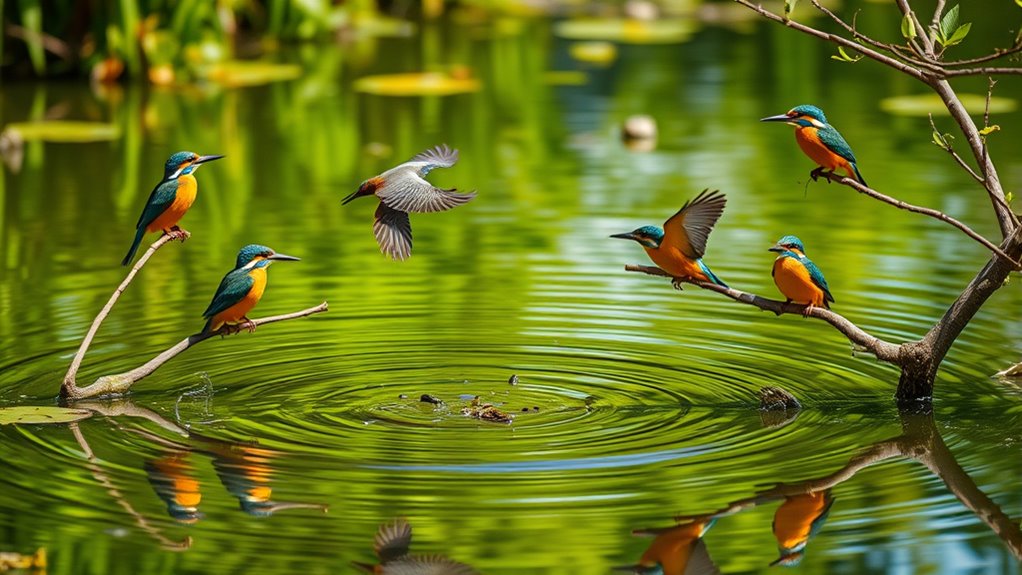
Providing a reliable water source is essential for attracting and supporting birds that help control caterpillars. Set up hydration stations, such as shallow bowls or birdbaths, in shaded areas to keep water clean and inviting. Incorporate water features like small ponds or bubbling fountains to create a natural, appealing environment for birds. Regularly refresh the water to prevent stagnation and keep it free of debris. Ensure the water is shallow enough for smaller birds to access safely. By maintaining these water sources, you encourage more birds to visit your garden, boosting their role as natural pest controllers. Remember, a consistent water supply not only attracts birds but also helps them stay healthy and active in your ecosystem.
Avoiding Pesticides to Protect Bird Health
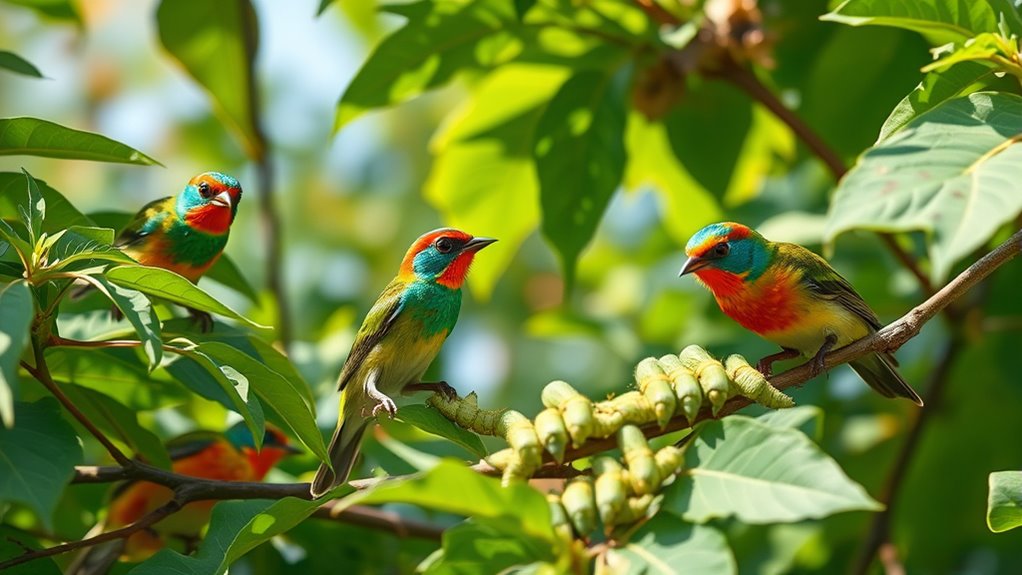
Why is avoiding pesticides essential for protecting your garden’s bird population? Pesticides can harm birds directly or contaminate their food sources, threatening their health and survival. To support bird health awareness, consider using pesticide alternatives like biological controls, neem oil, or manual removal. These methods reduce chemical exposure and preserve the natural balance. Here are four ways to minimize pesticide use:
- Choose organic or natural pest control options.
- Encourage beneficial insects that naturally control pests.
- Regularly inspect plants to catch infestations early.
- Remove pests manually when possible.
Planting Bird-Friendly Vegetation
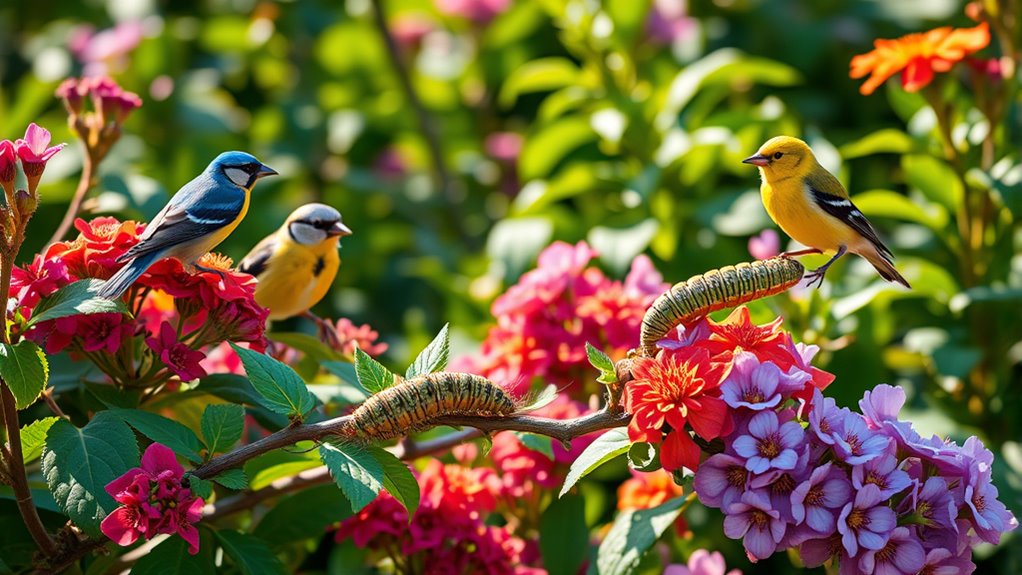
Choosing bird-friendly vegetation not only enhances your garden’s beauty but also creates a safe habitat for local bird populations. By planting native shrubs, trees, and flowering plants, you encourage birds to stay and thrive. These plants provide essential food sources and shelter, supporting their daily needs. As birds sing, they fill your garden with lively bird song, attracting more avian visitors. Additionally, your planting choices can influence migration patterns, helping birds pass through safely or settle temporarily. Diverse vegetation offers cover during nesting and protection from predators. As you select plants, consider species that bloom at different times, ensuring a steady supply of insects and seeds. Incorporating aesthetic wall organization and other decorative elements can further enhance the visual appeal of your garden space. Your efforts help sustain healthy bird populations, contributing to natural pest control and a vibrant, balanced garden ecosystem.
Encouraging Bird Observation and Engagement
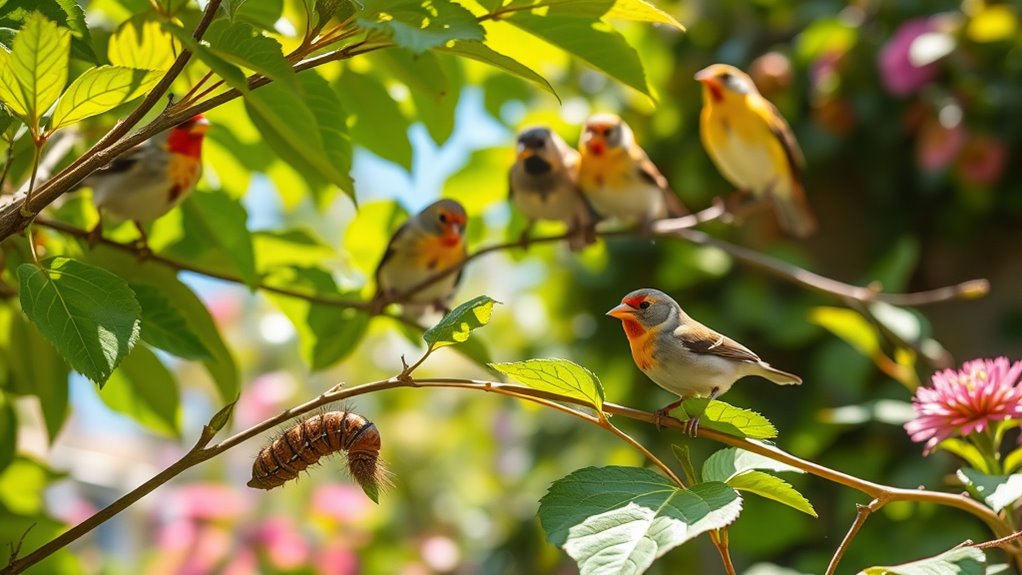
Creating opportunities for bird observation and engagement transforms your garden into a lively, interactive space. To attract birds, consider offering water sources, native plants, and nesting sites. Use birdwatching tips like quiet observation and noting bird behaviors to enhance your experience. Practice bird identification techniques by observing size, color, and song to distinguish species. To deepen engagement, set up a bird feeder station and keep a journal of sightings. Regularly update your garden with fresh plants and avoid pesticides to maintain a healthy environment. Engaging in bird-friendly gardening can further attract diverse bird species and support their natural behaviors. Engage children or visitors by sharing fun facts about local birds. These strategies encourage frequent visits, making birdwatching both educational and enjoyable, while naturally supporting caterpillar control through increased bird activity.
Frequently Asked Questions
Which Bird Species Are Most Effective at Controlling Caterpillars?
When wondering which bird species are most effective at controlling caterpillars, you should focus on beneficial bird species that naturally feed on these pests. Effective predator birds like chickadees, warblers, and thrushes hunt caterpillars and their larvae, helping reduce infestations. By attracting these beneficial birds to your yard with birdhouses and native plants, you support their role as natural pest controllers, making them an essential part of integrated pest management.
How Can I Identify the Best Bird-Friendly Plants for My Area?
To identify the best bird-friendly plants for your area, start with native plant selection, as these support local bird habitats best. Check local gardening guides or talk to native plant nurseries to find species that thrive in your climate. Look for plants that provide food, shelter, and nesting sites, such as native shrubs and trees. By choosing plants suited to your region, you’ll attract more birds and promote a healthy ecosystem.
What Are Natural Ways to Promote Bird Health and Longevity?
Boost bird brilliance by balancing bird nutrition and habitat diversity. Provide plenty of fresh, nutritious food sources like seeds and berries, and create cozy nesting spots. Avoid pesticides to protect their health and guarantee longevity. By broadening their habitat, you invite a variety of birds, enhancing their vitality. Together, these simple steps sustain their strength, support their survival, and foster vibrant, vigilant avian allies in your yard.
How Do Seasonal Changes Affect Bird Populations and Caterpillar Control?
Seasonal changes impact bird populations through shifts in migration patterns and breeding seasons. As seasons change, you’ll notice birds migrate to warmer areas or return for breeding, boosting local populations. During breeding seasons, bird activity increases, helping control caterpillars naturally. Understanding these patterns helps you anticipate when birds are most active, allowing you to support their presence and enhance natural pest control efforts effectively.
Can Attracting Birds Impact Other Pest Populations in My Garden?
Attracting birds can indeed impact other pest populations in your garden. By understanding bird migration patterns and preserving nesting sites, you encourage a diverse bird population that naturally controls various pests. Birds feed on more than just caterpillars, helping reduce insects like beetles and aphids. Your effort in creating a bird-friendly environment supports a healthy ecosystem, leading to fewer pests and a thriving garden.
Conclusion
So, go ahead—lure those birds in, build them fancy homes, and fill your yard with tempting snacks. After all, who wouldn’t want a bustling avian army to keep those pesky caterpillars at bay? Just remember, the more you pamper your feathered friends, the more they’ll stick around—probably demanding snacks and singing loudly at dawn. But hey, isn’t a little bird chaos worth a caterpillar-free garden? Happy bird-raising!
